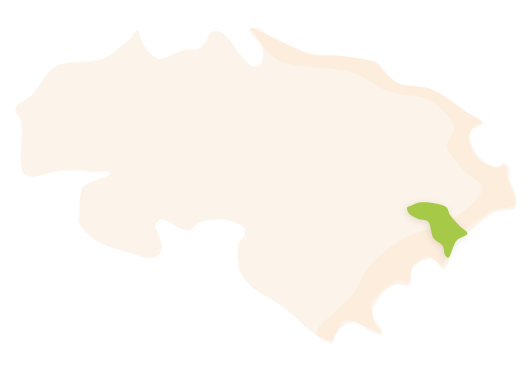El Poble Nou de Benitatxell is a small coastal town located in the southeastern part of the region. It sits at an altitude of 142 metres and has an extension of 12.7 km² filled with coves, cliffs and cultivated fields with vineyards on the slopes of the mount of La Llorença (435 metres). It has 4,447 inhabitants, known as Poblers and Pobleres.
 El Poble Nou de Benitatxell's municipal district. Surface area: 12.7 km². Population: 4,447 (INE data 2021).
El Poble Nou de Benitatxell's municipal district. Surface area: 12.7 km². Population: 4,447 (INE data 2021).
HISTORY
This town lies in a spectacular spot on the coastline of La Marina Alta, between the cape of La Nau and the cape of Or, among crags and cliffs where special fishing spots are hidden within the coves of Llebeig, Moraig and Els Testos. The underwater natural and geological heritage is noteworthy: a subterranean river, faults and caves by the sea.
Regarding the first evidence of settlement, one needs to go back 18,000 years, to the cave of El Moro, where materials from the Paleolithic, the Chalcolithic, and the Bronze Age were discovered. Remains from Iberian times can be found in other areas, like the hillock of L’Abiar and the cave known as Cova de Les Bruixes (the witches’ cave). There, the remains show that it was also occupied by the Romans and used for agriculture, mainly concentrated in L’Abiar. Apart from L’Abiar, the cave of Les Bruixes is a perfect spot to see evidence of the earliest human settlements: besides Iberian and Roman material, silos dug in the rock to store grain and ceramics from the Andalusian era have been found.
One of the most relevant legacies of the Islamic era is the toponymic contribution that even appears in the name of the municipality, Benitatxell (with references to Benitagell). Other noteworthy toponyms are the names of some rural areas, such as Lluca, Abiar, Alcassar, Moraig (Almoraig), Benicambra, etc. After the Christian conquest of Dénia in 1244, the rest of the territory and nearby settlements also began to be occupied by the Christians, including places such as El Poble Nou de Benitatxell. The municipal charter granted by the Catholic Monarchs in 1497 is noteworthy, but it seems that it did not take root. This, combined with the expulsion of the Moorish population in 1609, led to the depopulation and abandonment of the old Arab farms in L’Abiar and Benitagell between 1609 and 1617. From this date, the repopulation of the area began with Old Christians who mainly came from Majorca, the lower basin of El Segre and Lleida. However, it seems that it was not until 1698 when the population settled in the current town for good.
This land is also filled with more recent stories, like the ones about the bandits that roamed its paths and their hiding places, with the cave of Les Bruixes being an example of this: the bandits used to burn sulphur inside it to feed the fears of the local population so that they would not go near it. Or, during the difficult postwar period, the stories about how many families survived thanks to some fishing spots that were shelters hanging from the cliffs which allowed people to fish with an oil lamp. If you would like to learn about all these stories, a digital tool called ‘Un museu al vent’ (A museum in the wind) can be used, which is like a cross between an app and a series of suggested routes.
FESTIVITIES
- Saint Antoni is celebrated on the 17th of January.
- The festivities of La Rosa are celebrated around the first Sunday of May.
- The main festivities (festa major) are celebrated during the last two weeks of July and they last for 12 days.
GASTRONOMY
- “Putxero” (a type of stew) is typical throughout La Marina. However, in this town it is served with “pilota dolça” (a type of meatball which contains potato, bacon fat, sugar, cinnamon and bread), which makes it stand out.
- ”Cruet” is a typical dish made with rockfish, which gives it a very intense and distinctive flavour.
- Broad beans are deeply bound to the town. This legume is harvested in April, and the most typical dishes using it are “faves sacsades” (literally, “shaken broad beans”, which are usually sautéd with some vegetables and meat) and rice with broad beans.
- Raisin “caspells” is a delicious dessert that combines a simple dough made of flour, oil and sugar with almonds and raisins.